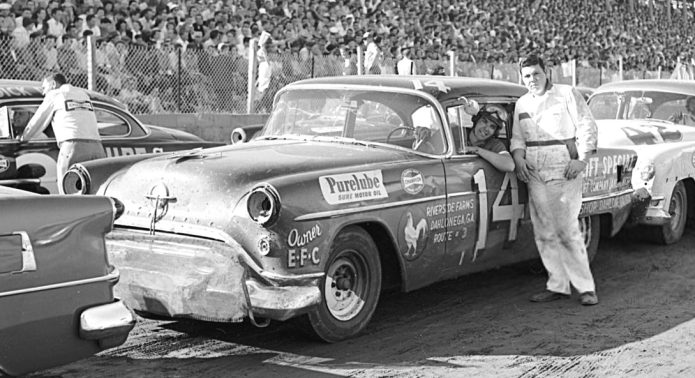In motorsports, NASCAR has been more than just a racing league; it’s a melting pot of innovation, competition, and unbridled passion. The journey of NASCAR is deeply intertwined with American culture. It is marked by roaring engines, the smell of burning rubber, and the unwavering pursuit of glory.
The story of NASCAR’s evolution is a rich topic for students, who often seek resources to deepen their understanding of such dynamic subjects. With the growing demand for comprehensive research, the phrase do my homework for me becomes more than a call for assistance; it’s a student’s way of seeking out in-depth studies and analyses. Through the lens of NASCAR’s history, students can gain insights into engineering marvels, strategic developments, and cultural impacts. As we delve into the NASCAR chronicles, let’s explore how this sport has evolved from humble beginnings to a high-octane spectacle, capturing the hearts of millions.
NASCAR’s Early Years
In the 1940s, the roar of engines began to echo across America’s South, signaling the birth of the National Association for Stock Car Auto Racing (NASCAR). Founded by Bill France Sr., NASCAR emerged from the Prohibition era’s bootlegging scene. This early period was characterized by rudimentary yet powerful vehicles racing on dirt tracks. These races were spectacles of raw power and daring, attracting a growing number of fans hungry for excitement.
NASCAR’s early years were marked by an ethos of ingenuity and resourcefulness. Drivers and mechanics worked tirelessly to push the limits of their machines, often using household materials and makeshift parts. This era laid the foundation for a culture of innovation that would define NASCAR for decades to come. The likes of Red Byron and Lee Petty didn’t just race; they wrote the first chapters of a legend, gripping the wheel of history and steering it towards an unknown but promising horizon.
Evolution of Stock Cars: From Basic to Bespoke
The transformation of stock cars over the years is a testament to NASCAR’s commitment to advancement and safety. Initially, stock cars were just that – standard production vehicles lightly modified for racing. However, the need for more specialized and safer racing machines grew as the sport grew. This growth can be divided into several fundamental developments:
- 1940s-1950s: Basic safety modifications, like roll bars, were introduced.
- 1960s: Introduction of the Holman-Moody Ford, a car specifically built for racing.
- 1970s: NASCAR begins to require roll cages, enhancing driver safety.
- 1980s: Introduction of power steering and disc brakes.
- 1990s: The Car of Tomorrow concept starts, focusing on driver safety.
- 2000s: Introduction of restrictor plates to reduce speeds at superspeedways.
- 2010s: Advanced telemetry and data analysis become integral to racing strategies.
- 2020s: Next Gen car debuts, featuring improved aerodynamics and safety features.
These advancements are chapters in a story of the relentless pursuit of excellence. Each decade brought its own challenges and breakthroughs, shaping the face of modern stock car racing. Today’s NASCAR vehicles are marvels of engineering, far removed from their humble beginnings yet still carrying the spirit of those early racers.
Iconic Tracks of NASCAR
NASCAR’s history is intrinsically linked to its iconic tracks, each with its own unique character and challenges. The Daytona International Speedway, with its high banks and legendary status, is more than just a track; it’s a cathedral of speed where history is made. The Talladega Superspeedway, known for its intense pack racing and breathtaking speeds, tests the limits of drivers and machines alike.
Then there’s the Bristol Motor Speedway, affectionately known as The Last Great Colosseum. Here, the short track’s high banks and close quarters make for some of the most intense and unpredictable racing in the sport. And let’s not forget the Charlotte Motor Speedway, the heart of NASCAR country, where the Coca-Cola 600 tests the endurance of drivers in a grueling battle against time and fatigue. These tracks are arenas where legends are forged, and dreams are realized or shattered.
Technological Advances: Pushing the Boundaries of Racing
NASCAR’s embrace of technology has revolutionized the sport in countless ways. From advancements in car design and safety to the integration of digital technology, the impact is far-reaching:
- Safety Innovations: Introduction of SAFER barriers and HANS devices.
- Aerodynamics: Constant refinement of car shapes for better performance.
- Fuel Efficiency: Development of more efficient engines and fuel systems.
- Data Analysis: Use of telemetry and software for real-time strategy adjustments.
- Simulation Training: Drivers using simulators for practice and strategy planning.
- Broadcast Technology: Enhanced viewing experiences with in-car cameras and graphics.
- Social Media: Greater fan engagement through digital platforms.
- E-Sports: The official NASCAR e-sports series.
These technological strides are not just about making the cars faster or the races safer; they’re about evolving the sport to meet the challenges of a new era. As technology continues to advance, NASCAR finds itself at the forefront of innovation, constantly redefining what is possible on and off the track.
NASCAR in American Society
NASCAR’s influence extends far beyond the racetrack; it has become a cultural phenomenon. The sport has given rise to a unique subculture, with devoted fans who cherish not just the races but the entire experience. Tailgating, fan festivals, and driver meet-and-greets are as much a part of NASCAR as the checkered flag. This community spirit creates a sense of belonging, uniting people from diverse backgrounds in their shared love for the sport.
Moreover, NASCAR has played a significant role in American pop culture. It has been featured in movies, television shows, and music, often symbolizing themes of freedom, competition, and the American spirit. The sport has also been a platform for social change, promoting diversity and inclusion in what was once perceived as a predominantly male-dominated arena. As NASCAR continues to evolve, it remains a mirror reflecting the changing dynamics of American society.
Conclusion
NASCAR’s story is one of relentless innovation, fierce competition, and a deep connection with its fans. From the early days of bootleggers outrunning the law to the high-tech, high-speed battles of today, NASCAR has continually redefined the boundaries of motorsport. It’s more than just a series of races; it’s a cultural touchstone that speaks to the spirit of determination and the pursuit of excellence. The influence of NASCAR extends beyond the track, impacting technology, culture, and even societal values, making it a unique and enduring part of American history.
- Todd Gilliland and the No. 38 gener8tor Ford Mustang Dark Horse Darlington (S.C.) Raceway Competition Notes - May 8, 2024
- Alltroo Teams up with 23XI Racing and Bubba Wallace to Spotlight Charitable Organizations During All-Star Weekend - May 8, 2024
- Delta Speedway Returns Saturday Night May 11th for Second Race of 2024 - May 8, 2024


